The Assassination of Jesse James by the Coward Robert Ford (Blu-ray review)
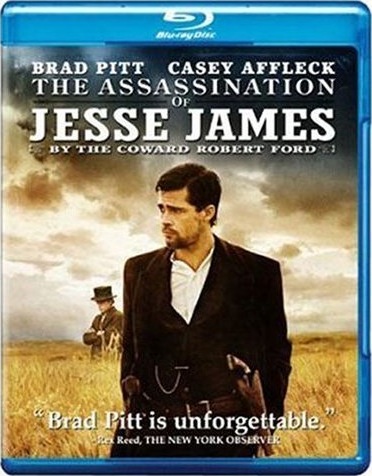
I still remember the first time I ever heard the name “Jesse James.” It was on an episode of the Brady Bunch in which Bobby announced that his new hero was the outlaw Jesse James. Of course Mike and Carol were horrified so greatly that they went to all the trouble to find someone whose family had been killed (decades earlier) by the notorious outlaw. Then Bobby saw how wrong he had been and all was right in the Brady world until Marcia broke her nose in the next episode.
Of course at the time, I had to wonder how Jesse James could have ever been anyone’s hero. Nevertheless, both in James’ own lifetime, and in the years that would follow, he was very much the hero to many people, especially to those in the post Civil War South. He was looked upon as “Robin Hood” character to some, one who as a former Confederate guerrilla stood up to “Northern oppressors” both during the Civil War and afterwards. The real Jesse James was a bit of a psychopath, in spite of his role as a family man and his singing in the church choir. But of course, the neighbors of serial killers are always shocked, too, because after all, “he seemed so normal.”
The James brothers were so popular in their day that when Frank James finally turned himself in (not depicted in the movie), he only faced two trials and no jury would sentence him to jail time, let alone pass down a death sentence which the average criminal of his day committing similar crimes would have surely received.
The Assassination of Jesse James by the Coward Robert Ford is also the name of the novel by Ron Hansen upon which the screenplay was based. According to the trivia at the Internet Movie Database, Brad Pitt (who stars as Jesse James) had a clause in his contract that would not allow the name of the movie to be changed. No doubt he was concerned that some studio executive with more power than insight might feat that the title is too long. And perhaps it is, but within that title the entire plot (and perspective) of the movie is told.
In the original novel Hansen attempted to write an account that may have been truer to the actual events as opposed to a lot of the sensationalized accounts surrounding Jesse James that began to appear even within the outlaw’s lifetime. Certain elements such as dialogue and even motives are fictionalized, but the fiction is based upon known events and reasoned speculation. Due to this approach, the movie is not the fast paced, action packed western that many fans of the genre may be used to. In fact, the story simply plods along at times, but this is not by accident. The events surrounding James’ death are complex and the creators of this movie take the time to introduce characters and establish intricate relationships. The original cut came in at an epic length of four hours, but the studio required that it be cut further; and the final running time is two hours and forty minutes.

Part of the reason Pitt was able to keep me on edge was due largely to the outstanding performance by Casey Affleck who played Robert Ford. Despite Pitt’s top billing, the movie is mostly told from Ford’s point of view. Affleck expertly portrays the insecure, hero-worshiping friend-turned-traitor, Robert Ford. In his first scene when Ford is trying to persuade Frank James to let him be his “sidekick” for a train robbery, Affleck demonstrates Ford’s uncertainty and admiration at the same time by rushing his words and failing to look James in the eye. Affleck’s portrayal of Robert Ford reminded me of a fellow in high school I knew who wasn’t initially part of a popular clique but became accepted by them nonetheless. And after his acceptance, his enthusiasm to fit in became obnoxious to the point that he actually began to view his new clique with contempt and eventually moved on to another. I remember some of the fellows saying, “We created a monster.”
In Ford’s admiration of the James brothers’ celebrity, he desired to have celebrity of his own which he found by turning on his mentor, Jesse James. But Ford’s celebrity would be short lived as he turned from being the man who brought down the most infamous outlaw of the 19th century to the one sung of as “the coward who shot Mr. Howard” (one of Jesse James’ aliases).
More interesting to me than the movie itself was the documentary included on the disc that provided the factual background to the movie including a social-psychological profile on James regarding what may have made him into the person he was and what led up to his assassination by one of his own gang members. However, the documentary would not have been as intriguing without seeing the movie first. Other than this, the disc is bereft of any additional features. Despite Blu-ray’s claim to 50 GB per disc, studios seem to rarely take advantage of the disc’s capacity. Despite the excellent high def movie experience, if Blu-ray fails to catch on, it may be from distributors creating limited offerings while charging premium prices.
My copy of The Assassination of Jesse James by the Coward Robert Ford came through my NetFlix subscription. The movie is good enough for a rental, but unless you have other interests in the historical character or the period, I don’t recommend it for your private collection.
The Return of the Disciple's Study Bible, Now in HCSB

The Disciple’s Study Bible was a project from Holman Bible Publishers two decades ago that took the NIV text and added study notes based around a core set of doctrines. Although there was enough content in the Disciple’s Study Bible to make it a self-contained resource on its own, the real value of it could be found when using it in conjunction with the accompanying workbook and leader’s guide. The workbook itself had 65 individual lessons for use in private or group settings.
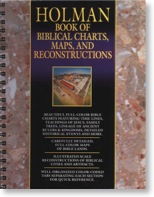
After seeing the Bible on eBay, I looked on Amazon to only confirm that the Disciple’s Study Bible is now out of print. I wasn’t overly surprised to learn this as I had not seen it on store shelves for quite some time. It is still available used on Amazon ranging in asking price from $35 to $250 according to the edition.
I pulled my copy of the Disciple’s Study Bible off the shelf along with the workbook and flipped through both. Honestly, it’s been years since I looked through either, but as I surveyed the content, I thought to myself that it would be very useful in a church discipleship context. And then it struck me that the Disciple’s Study Bible would be a perfect fit for Lifeway’s in-house translation, the Holman Christian Standard Bible. This would mean that B&H could produce the Bible without having to pay licensing fees to another company as had been done when it was based on the NIV.
So I shot off a message to B&H Publishing customer service and suggested that the Disciple’s Study Bible be retooled for the HCSB. Evidently great minds think alike because I got a response back this morning letting me know that there are indeed plans to re-publish the Disciple’s Study Bible in the HCSB, and it is slated to be released late in 2009.
Since there is a revision to the HCSB slated for 2009, I would assume that the new edition of the Disciple’s Study Bible will contain the newest text.
Starbucks and "Free" WiFi: They STILL Don't Get It
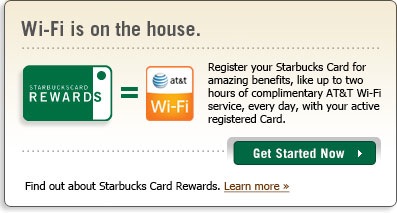
Okay, I consider myself fairly savvy when it comes to technology. I’ve been using computers in one form or another since 1982. I have a great appreciation for technology that is user friendly, and little patience for technology which is not. I mean, as of this year, we’re now thirty years into the personal computer revolution. Something like connecting to wi-fi internet in a coffee shop shouldn’t be that difficult, right?
Kathy was meeting some teacher friends she used to work with in Louisville tonight, and she asked me if I wanted to tag along. I asked where she was going, and she said “Starbucks.” I groaned. Why not Java Brewing Company? Why not Heine Brothers? Why not Panera? These other coffee shops have no-hassle, easy to access wi-fi. My last experience at Starbucks, described in the link at the top of this post just didn’t turn out that well. Don’t get me wrong--I like Starbucks coffee better than these other places. But because Starbucks’ wi-fi is such a pain, I’ve relegated Starbucks to drive throughs-only over the past couple of years. When I want to hang out in a coffee shop, I go to one of the other places for easy internet access.
So tonight I went with Kathy anyway, figuring I could give the Starbucks one more shot. I needed to grade some papers, and I email out progress reports when I’m through. Granted, I could send the emails out when I got home; maybe I’m just addicted to the internet and feel a need to always be connected.
The first thing I did was ask the barista behind the counter how I would go about getting on the internet. I just played dumb so I could get full information about logging on--in case I had missed something the first time around. No, I had everything right after all. However, I couldn’t find my registered Starbucks card. Perhaps in the nonsense that transpired in July, I had left it in the Starbucks in Louisiana where I unsuccessfully tried to log on.
So, I purchased a new card with the minimum $5 balance to get “free” internet, and went to a table. The barista had told me that if I had trouble getting online, I could call the 800 number on the back of the card. My MacBook immediately connected to the Starbuck’s wi-fi and upon launching Safari, I got this screen:
Now, look at that screen and tell me from the perspective of a Starbucks customer, what I’m supposed to do next. There wasn’t even mention of Starbucks on the screen. So I dialed the 800 number on the back of my card. The automated service went through about half a dozen options, none of which were related to in-store wi-fi, so I pressed nothing and was put into the queue. A message informed me that hold times were unusually long.
After an incredibly long wait, a very nice person named Brianna answered the phone. I told her my situation, and she instructed me to type http://www.starbucks.com into the URL line of my browser so that I could register my card.
What?!
Look carefully at the screenshot above. Was there any indication that I could go to starbucks.com? Was there a link anywhere that even mentioned Starbucks? No, there wasn’t. And attempts to go to any other website were blocked.
After getting to the Starbucks site, the steps for registering my card and signing up for “wi-fi rewards” were pretty straight forward. In fact, I told Brianna that I could probably handle it from thereon. However, I suggested to her that all of this would have been much simpler if there had been some kind of link or information on the AT&T screen indicating that I should go to starbucks.com to register my card. She simply said, “Yes, that is a problem we’re aware of.”
So I hung up with Brianna, completed the registration of my card, which took me back to the AT&T login screen. I entered my user name and password but I still couldn’t connect to the internet. I regretted letting Brianna go so quickly.
At this point, I simply felt I needed to grade my papers. “Forget it,” I told myself, picking up my iPhone to check my email. The iPhone had automatically connected to the store’s wi-fi which I knew would be a bust for the same reason I couldn’t log on with my MacBook. So I disconnected my iPhone from wi-fi and hit the internet through the Edge network. In my inbox came this email:

Here was the reason I had been unable to connect to the internet: I had to click on an emailed link to complete my registration. Had my iPhone, which is email capable, not been with me, I could not have completed this step until I returned home. So I clicked the link which led to this screen on the iPhone’s Safari browser:

I tried logging into AT&T on my MacBook again, and finally I achieved success:

But can you see how inane this entire process is? The process to connect to the internet cannot be finalized in-store unless the user can receive an email to validate registration. However, the user cannot receive the email because the registration has not been validated. This is one of the stupidest processes I’ve ever seen! Who designed this system? Had I not been able to access my email by another device, I would have never been able to connect until my next visit to Starbucks.
How long did this process take from the moment I came in to the point I connected? Forty minutes.
After connecting finally, I looked up and saw Kathy saying goodbye to her friends. She was ready to leave.
So maybe next time, but maybe not. I realize that I won’t have trouble connecting the next time I’m in a Starbucks, but I’m highly offended at how unfriendly the entire system is. And the company wonders why it is suffering financially lately?
One more thing: for the record, Starbucks wi-fi is not really free (or “on the house” as they like to call it). It’s impossible to access the internet unless the user purchases a Starbucks gift card and keeps a $5 minimum and uses the card within a set period. So not only do I have to pay up front, I have to continue paying at certain intervals if I am going to use their “on the house” internet.
But really... if I have to purchase something to get something, then, I’m sorry, but it’s not “on the house.”
Review: MacGourmet Deluxe
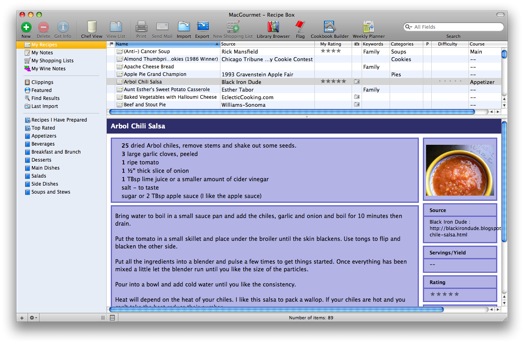
Click on image above for larger view.
Recipe database programs have been around in one form or another as long as personal computers have been in homes. Some of these are standalone programs dedicated to recipes, but even standard database programs such as FileMaker Pro come with recipe templates. I’ve been using personal computers since 1982, and I’ve kept recipes saved electronically (in word processing documents or PDF files) since the first computer we had with a hard drive, way back in 1988. But I’ve never been impressed with recipe database software...until now.
Now, let me say up front: yes, you can see a MacGourmet Deluxe (MGD from this point forward) advertisement in the sidebar [only at cookingincastiron.com, not at This Lamp]. But what you must realize is that I first contacted Mariner Software in regard to their advertising with us because I was incredibly impressed with this software. In fact, as I already mentioned, recipe database software is nothing new, but in reality, MGD seems to me to be the mature end result of nearly three decades of this kind of software that has gone before it. I strongly encourage you to download the MGD user manual as I will not be able to nearly touch upon all of MGD’s features in this review. I’ve jokingly said to a friend that MGD seems to do everything except cook the meal for you, but maybe that’s projected for version 2.0.
Of course, MGD does what you would expect--it allows you to keep a database of your recipes. The interface is iTunes-esque, allowing you to create your own categories in the left sidebar. And like an iTunes smart playlist that automatically expands as new songs meet pre-set criteria, MGD allows the user to create “smart recipe lists” that look for certain criteria as the user adds new recipes.
One of the most impressive features of MGD is the multiple ways that recipes can be added to the database. Certainly, the user can enter ingredients and directions manually, but there are also a number of ways to add them automatically from other sources. There are “supported” websites such as allrecipes.com, epicurious.com, foodnetwork.com, williams-sonoma.com, cookinglight.com and food.yahoo.com in which all a user has to do is select the URL on a recipe’s webpage, go to the services menu: MaGourmet, and choose “Import Recipe from Web Page.” 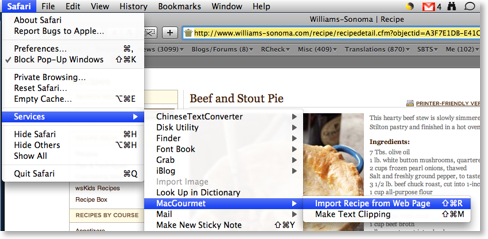
MGD automatically parses the information, separating the ingredients from the directions, the description of the recipe and even includes the picture:
But what if a website is not supported? Well, to test this out, I went to one of my favorite cast iron related websites, “Black Iron Dude.” About a month ago, there was a recipe at this website for Arbol Chile Salsa. To import the recipe from Greg’s website, I first highlighted all the text in his post and then I dragged it to the “Clippings” window in MGD. This is a great little window in MGD that allows the user to drag over recipe after recipe and then go back and format them later. After I had dragged over the text for the salsa, I double-clicked on it to import it in my recipe database. 
All of my captured text is gathered at the top of the import window. From the drop down menu, I can select “Ingredients” and MGD knows that this information is separate from the preparation directions. And of course, I can do the same with the directions, information about the recipe, etc.
What impressed me further is that in parsing the list of ingredients, MGD could distinguish between number, actual item and special instructions. Notice for example in the list below, taken from this recipe, that “25” is separated from “dried Arbol chiles” which is separated from “remove stems and shake out some seeds”: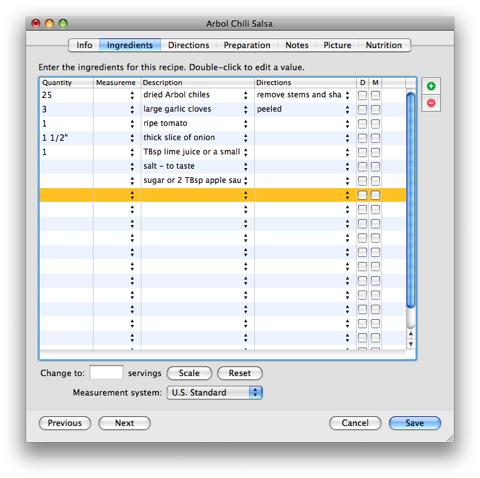
For those watching what they eat (and who isn’t these days?) MGD comes with the abbreviated USDA National Nutrient Database. Ingredients are automatically evaluated by this database and if MGD is unsure about a particular ingredient, the user can open up the USDA database and manually map ingredients. Once all ingredients are mapped and servings are figured, MGD calculates an extremely accurate breakdown of nutritional data.
This information is calculated for 45 separate items:
And when printing out recipes for personal use or to share an abbreviated box with nutritional information is included such as this breakdown for JT’s Family Pancake Recipe: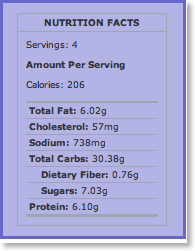
This kind of information would be extremely helpful not only for the person watching what he or she eats, but also for the personal chef or any person in charge of providing meals for groups of people. MGD includes a weekly meal planner that can be exported to iCal, and shopping lists can be created from planned recipes.
Kathy and I have an older iMac we keep in the kitchen for easy access to recipes we’ve collected electronically over the years. Whether you have a dedicated kitchen computer or simply a laptop on the counter, MGD offers a “Chef’s View” that enlarges ingredients and directions for easy access:
Almost every church group or civic organization has produced a cookbook at one time or another. There are publishers who specialize in this. These publishers should be a bit concerned for their future because MGD includes tools for creating one’s own cookbook with pictures, section dividers, chapters, and more. Once a cookbook has been created it can be exported to PDF ready for publication from a company such as Lulu.com.
And of course, when someone asks you for your Garlic Beef Enchiladas recipe after the church potluck, you can print out your recipe according to a variety of attractive built in templates.
As the name implies, MacGourmet Deluxe only runs on Macintosh computers, but the program is so sophisticated, it might be reason enough to switch from Windows if you aren’t already a Mac user. Regardless, MGD can import files in a number of formats: MasterCook, MasterCook Mac, Meal-Master, CookWare Deluxe, Cook’n text, RecipeML, and Yum XML. It can export to iPod notes, MasterCook, MealMaster, RTF and text files.
Our Cooking in Cast Iron website is still fairly new, but as we add recipes in the future, we will also make them available in MGD format which means that if you want to add one of them to your own collection, it will be as easy as dragging an icon from our website directly into your MGD database.
MacGourmet Deluxe is available from Mariner Software for $44.95.
Kathy's Ode to the NLT
Sunday, while we were at church, our pastor was preaching from Amos in the NIV, but the words of Scripture on the screen behind him were in the NLT. Kathy saw this as possibly divine interference because she thinks everyone should read from the NLT. She kept nudging me asking, “Why doesn’t he just use the NLT? It’s much easier to understand!” I mumbled something about “1 Corinthians 14:34,” but she just elbowed me even harder.
Don’t tell our pastor, but inspired by the disjunction between speech and screen, Kathy immediately set to writing a little ditty expressing her feelings about the New Living Translation.
You can read it over at her blog (yes, she has one, too) in the post “Ode to the NLT.”
Lizards & Spiders & Targums, Oh My! [UPDATED]
It’s true-- check it out. Every major translation other than the KJV and NKJV contains lizard instead of spider:
Proverbs 30:28 |
|
| KJV | The spider taketh hold with her hands, and is in kings’ palaces. |
| NKJV | The spider* skillfully grasps with its hands, *Or lizard |
| RV/ASV | The lizard taketh hold with her hands, Yet is she in kings’ palaces. |
| RSV/ESV | the lizard you can take in your hands, yet it is in kings’ palaces. |
| NASB | The lizard you may grasp with the hands, Yet it is in kings’ palaces. |
| NIV/TNIV | a lizard can be caught with the hand, yet it is found in kings’ palaces. |
| JPS | You can catch the lizard in your hand, Yet it is found in royal palaces. |
| NRSV | the lizard* can be grasped in the hand, *Or spider |
| NLT | Lizards—they are easy to catch, but they are found even in kings’ palaces. |
| HCSB | a lizard* can be caught in your hands, *Or spider |
| NET | a lizard you can catch with the hand, but it gets into the palaces of the king. |
| NETS | and the lizard, though dependent on its hands and being easily caught, it lives in the king’s fortresses. |
So, of course I turned to Accordance. I opened up both the NASB and BHS Hebrew Bible modules side by side because I knew that I didn't know the Hebrew word for spider/lizard off the top of my head and the NASB has Hebrew tagging. After determining שׂממית/semamit was the word in question, I triple clicked on it to open the Hebrew and Aramaic Lexicon of the Old Testament (HALOT).

To double-check, I switched over to Brown-Drivers-Briggs Hebrew lexicon. It's still a lizard of some kind. Definitely not a spider.
So where in the world did the King James translators get "spider"?
I've come to the point in the last couple of years that when I want a quick answer to questions like that, I simply turn first to the NET Bible notes. Sure, commentaries are great for more in depth information, but the NET Bible notes have the answer in a nutshell--usually. I mean, normally there's an answer for everything in those 60K+ notes.
Sure enough, the NET Bible seemed to have it covered:
"The KJV, agreeing with Tg. Prov 30:28, translated this term as ‘spider.’ But almost all modern English versions and commentators, following the Greek and the Latin versions, have ‘lizard.’”
Okay, so this made a good bit of sense to me. The KJV Old Testament translators had a reputation for being very familiar with Jewish literature. Perhaps even the meaning of שׂממית was in question, and they turned to the Targums for answers.
For the curious, here is Prov 30:28 in the LXX and Latin as referred to in the NET Bible Note:
| LXX | καὶ καλαβώτης χερσὶν ἐρειδόμενος καὶ εὐάλωτος ὢν κατοικεῖ ἐν ὀχυρώμασιν βασιλέως |
| VULGATE | stilio manibus nititur et moratur in aedibus regis |
As expected, both the LXX and the Vulgate refer to a lizard (or a spotted lizard, or a gecko).
Now, I’ve got the Targums in Accordance as well, but I’ve never really used them much. In fact, I discovered in trying to look up Proverbs 30:28 that I didn’t even have the newest release. After installing the updated set of modules, I was able to look up the passage.
There is indeed a different word here, אקמת/’qmt. I couldn’t find the word in either Hebrew Lexicon, and it does not seem to be similar to the Hebrew word for spider (עכביש/‘akkavish). However, if I understand the nature of the Targums correctly, Proverbs was actually copied from the Syriac Peshitta. So, this really isn’t even Hebrew/Aramaic, but rather Syriac. And thus, this is really outside my language skills. Further, I don’t have an English translation of the Targum for Prov 30:28. However, the English gloss in Accordance for אקמת/’qmt is lizard.
Regardless I would be interested in further information. Perhaps Iyov (if you’re back from your travels) or John Hobbins might offer some insight.
UPDATE: As expected, Iyov provided helpful information in the comments:

I would find it a bit remarkable if the KJV used the Targums -- I do not believe they were expert in Aramaic, and Targum to Proverbs is a bit obscure even today.”
So it seems to me--at this point--that it may indeed be the NET Bible notes that are in error. The source for “spider” in the KJV & NKJV seems to be the medieval commentator Rashi, not the Targum on Prov 30:28, which according to the English gloss in Accordance, also uses a word for lizard, not spider.
Olive Tree Comes to the iPhone: Finally the Promise of a Decent Bible App
Well, wait... there was still my iPod, obtained in 2002. Although I didn’t carry it with me everywhere as I had done with the cell phone and PDA, it was still handy for listening to audio books, the Mars Hill Audio Journal, and occasionally some music. But it was always something else to keep up with.
Then in 2007, my electronic gadget world converged one more time with the iPhone. Now I had a PDA, cell phone and iPod all in one device. But two things were missing on the iPhone that I had used quite extensively on previous Palm PDAs, including my Treo: Pocket Quicken and Bible software from Olive Tree.
Intuit now has an online version of Quicken that works with the iPhone, but I’m not yet sold on the idea of placing all my financial data into “the cloud.” Originally Apple was not going to open the iPhone to 3rd party applications, insisting that all such endeavors were to be handled through Web 2.0 internet apps. Regarding Bible applications, there were initially some halfway decent web apps, but they had two drawbacks: (1) they were all dependent upon internet connectivity to work, and (2) there was no real support for original language texts.
With the advent of iPhone 2.0 software last month, we were finally able to obtain true third party applications on our iPhones. But as I had previously written, I had been enormously underwhelmed by initial offerings because they were either lackluster or required internet connectivity to function.
Yesterday, Olive Tree launched its first offerings for the iPhone: its BibleReader and ESV Study Bundle for Bible Reader.
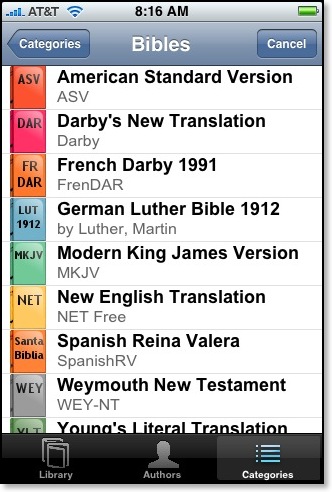
- American Standard Version
- Darby’s New Translation
- French Darby 1991
- German Luther Bible 1912
- Modern King James Version
- New English Translation (without notes)
- Spanish Reina Valera
- Weymouth New Testament
- Young’s Literal Translation
None of the texts in the free edition are formatted yet (image below on left), but as this screenshot taken iTunes (image below on right) shows, the ESV text is formatted:

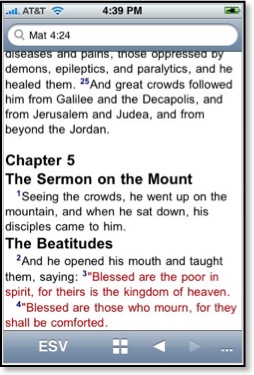
I’m not sure yet if the red lettering can be turned off. The ability to turn off red lettering will come in a later update.
The search dialogue at the top of the screen can be used for either direct reference input or word searches. It also automatically updates as the user scrolls through the biblical text. A search for “righteousness” yields 134 hits in the NET Bible as seen below:
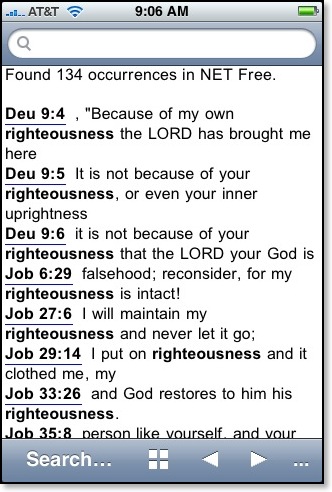
Touching any of the underlined references takes the user to the verse in context of the entire passage. Pressing the icon at the bottom of the screen (is that a window or a plus sign?) brings up a listing of all books available in that particular Bible module:
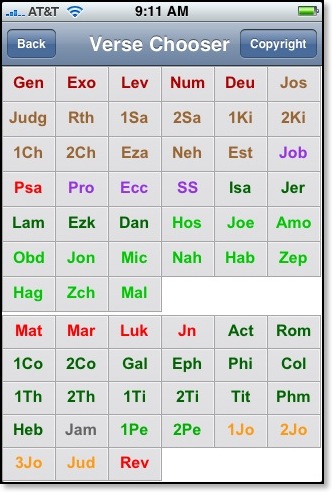
Clicking on any of the biblical books leads to another screen (not pictured) that lists all chapters in the biblical book and then to another screen with all verses. Selecting a particular verse will not display the verse by itself but the entire passage in context which is very helpful.
The most beneficial aspect of Olive Tree’s BibleReader is easily that it does not rely on an internet connection to use any of the biblical modules. All texts are fully loaded onto the iPhone. I especially appreciate that because I still find myself without any signal from AT&T at times when I am deep into the heart of a building--especially older buildings. At this point, I’m not worried about space limitations. iPhones now come in either 8 or 16 GB models, so for most users there should be room to spare. This is in contrast to my old Treo 600, of course, with which I had to use an extra SIM card in order to store all 60,000 notes of the NET Bible.
The interface for Olive Tree’s BibleReader is completely customizable as seen in this settings screenshot:

In fact, until I installed BibleReader, I had no idea what fonts were available on my iPhone:
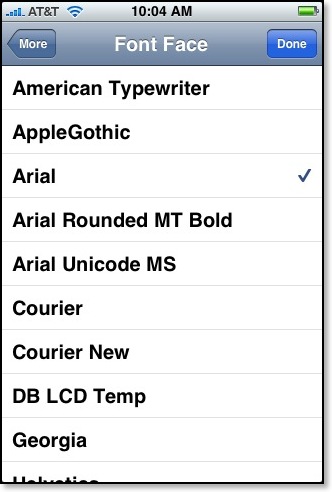
[In addition to the fonts listed in the graphic above, BibleReader also tells me I have the following typefaces installed on my iPhone: Helvetica, Helvetica Neue, Hiragino Kaku Gothic ProN W3, Hiragino Kaku Gothic ProN W6, Marker Felt,
STHeiti J, STHeiti K, STHeiti SC, STHeiti TC, Times New Roman, Trebuchet MS, and Verdana.]
I noted in the title of this blog entry that Olive Tree’s BibleReader was the first third-party iPhone Bible app with real promise. I say that because not all of their extensive language offerings are available yet, including their Greek and Hebrew texts. But I corresponded with Stephen Johnson of Olive Tree yesterday, and he assures me they are in the works along with many of the other modules in Olive Tree’s library.
Certain features that we’ve come to expect from Olive Tree, such as split screens, aren’t available yet, but features will be added to BibleReader over the next few months.
Users such as myself who had already purchased Olive Tree texts may face a bit of a conundrum. In the past if a customer had bought a module for the Palm platform and then switched to the WindowsMobile platform (or vice-versa), it wasn’t necessary to re-purchase the texts. For instance, a few years back I briefly owned a Compaq iPaq and was able to load modules such as the Greek New Testament with Gramcord morphology onto the Compaq device even though I had previously purchased it for the Palm platform. After a few weeks, I decided connecting to a WindowsMobile (I believe it was called WindowsCE back then) device from a Mac was too much hassle and switched back to a Palm PDA. In all of this switching back and forth, I never had to pay anything extra to OliveTree. I’ve always found their cross-platofrm policy to be very generous.
However, with the iPhone, the issue is a bit more complex and the problem doesn’t lie with Olive Tree, but with the iTunes Store. Apple doesn’t allow third-party iPhone developers to sell their applications from their own websites. It has to be done from the iTunes Store. So, for instance, if a user has already purchased the ESV text for a Palm or WindowsMobile device from Olive Tree, there’s no way at present to keep from paying for it again if purchased for the iPhone. Olive Tree is in talks with Apple to determine if there’s a way around this, but for right now if an ESV aficionado already bought it for another platform and now wants to install it on the iPhone, he or she will have to pony up another $24.99.
And there is another problem for Olive Tree and their customers. Olive Tree’s modular model of distributing texts doesn’t work as well with the iTunes Store. In the past on the Palm or WindowsMobile platforms, once the BibleReader software was installed as many text modules could be added as their was room available in the device’s memory. Currently, the iTunes Store doesn’t allow this adding of one text at a time as the previous model allowed--at least not without having many separate apps installed on the iPhone. So, if for instance, Olive Tree releases the TNIV text next week, a user couldn’t simply add it to an already-purchased ESV Study Bundle. Rather, two separate installations of BibleReader would have to be installed with the TNIV in one and the ESV and accompanying resources in the other. And theoretically, even once split screen features are implemented, modules in two separate installations couldn’t be viewed side by side.
This complication is not something that just affects Olive Tree, but rather all developers who offer modular add ons to its software. Again, Olive Tree is in talks with Apple, and hopefully the way iTunes is currently set up can be adjusted for the benefit of the customer in the future.
Regardless of these early snags, Olive Tree’s venture into the iPhone platform looks very promising. I am hopeful I can eventually reproduce the same functionality with Bible texts on my iPhone that I had previously experienced on my Treo. Since useful iPhone Bible functionality is something I am genuinely seeking, expect to see more on This Lamp about the subject as new developments arise.
For further information:
Olive Tree’s iPhone Page
Olive Tree’s Blog
The Kind of Stuff I Find Nowhere Else III
Now, I didn’t actually find the items below myself. You may have seen the pictures below as they’re from an email making the rounds in conjunction with the beginning of the Olympics in Beijing, although they may have their origin in an earlier context. The photos are attributed to a “G. Pollack,” and I don’t know who he is, but from the briefest of research I did on the internet, evidently the pictures are really from the Beijing market.
You know, I’m much more adventurous in what I’ll eat than Kathy. After seeing these pictures, she said that when we go to China next year, she’s going to take plenty of Ramen noodles with her. I don’t know why she’s selected Ramen noodles. I’d assume that noodles would be in abundance in China. I, however, may carry a number of PowerBars with me.
You know, I’d not be opposed to eating sea urchin--as long as it was cooked--but the problem is that I don’t know how to eat sea urchin!

Starfish fried in shark oil.

Baby sharks, deep fried star fish, and sea urchins.

Top left: turkey vulture schnitzels; bottom left: sea snakes; bottom right: silk worms

Snake about to be grilled

Dog liver with vegetables (don’t tell Bessie Mae!)

Goat lungs with red peppers

Mixed cow and horse stew

Top row: silk worms, black scorpions, and dung beetles; bottom: cicadas

Scorpion brochettes

Lizard legs

Dog brain soup

Oysters, squid, and iguana tails

Assorted scorpions & beetles

Scorpions, crickets, and beetles

Seahorses

Grilled snake and silk worms
Just remember what Mom said: “You can’t get up from the table until you try at least one bite of everything on your plate.
Don't Be a Poser
“Beware of practicing your righteousness before other people in order to be seen by them, for then you will have no reward from your Father who is in heaven.” (Matt 6:1, ESV)
I take the above command from Jesus’ Sermon on the Mount very seriously. There’s a balance, right? --between absolutely hiding one’s faith and on the other hand simply making a show of it.
For the last three years, my friend JT and I have met each other for breakfast and conversation on Thursday mornings. JT’s a sharp guy who as a chemical engineer (he can correct that designation if it’s wrong) rose to an executive status in a national corporation. JT is exactly the kind of guy I want to think is represented all around our nation’s workforce. He’s a Christian who takes his faith seriously, who sees the world from a biblical perspective and makes decisions from an ethical point of view. JT is well-read in literature, loves history and philosophy and has a desire to go beyond Sunday School-level faith.
As I mentioned, JT and I have been meeting almost every week for at least the last three years. Sometimes we merely have conversation. Sometimes we study the Scriptures. We’ve read a few books together and discussed them over breakfast. The first book we ever read together set the stage for our breakfasts, Love Your God with All Your Mind by J. P. Moreland and Dallas Willard. In fact, the review of this book here on This Lamp was written by JT. Although I consider myself more of a “biblical studies” kind of guy, JT wanted to have a better grasp on doctrine, so we spent well over a year reading through a systematic theology. We read through Bonhoeffer’s Cost of Discipleship together. You get the idea.
When we meet, we have our discussions, but we’re not showy about it. We may have our Bibles out, but we don’t go into long and loud prayer sessions like I see some Christians do when they meet in public. We often trade prayer concerns, but we realize that our meeting is not the only opportunity we will have that week to pray.
A while back when the first edition of the NET Bible was released, I gave JT my “2nd Beta edition” which he has now adopted as his primary Bible. Like most of us, he loves the detail of the notes. Yesterday when we met, he had his copy of the NET Bible on the table. My copy of the TNIV Reference Bible and my Greek NT were still in my book bag. We briefly discussed the content of a recent Sunday School lesson. JT and I don’t go to the same church, but our churches use the same curriculum, so we often compare notes from our studies.
As we were talking yesterday at a cafe in Louisville, a fellow--probably in his late twenties or early thirties--sat down at the table next to ours facing us, or really just facing me. Now, I have this Jason Bourne-spy-style habit of watching others in the room out of my peripheral vision. I can’t help it, but if anyone every whips out a submachine gun, I’ll be the first one ducking.
I could tell immediately that the guy at the next table was a poser. He sat with his back to the entrance (proving he wasn’t a super spy like me and Jason Bourne because we’d never sit with our backs to the door), mainly--I believe--so that he could face us, obviously having seen JT’s NET Bible on the table. He pulled from his book bag a Dell laptop, headphones, and an ESV Bible. How do I know it was an ESV Bible? Well, it was one of the hardback editions with the black and white cover that have “ESV” in large letters on the front. He attempted to subtly push the Bible across the table toward us so that from my perspective, I could see the letters facing us and know he had a Bible just as we did.
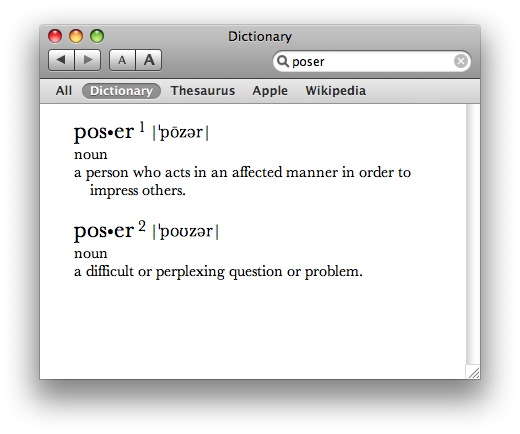
Now, this is a pet peeve of mine. As a Christian, it really bothers me that there’s this cultural perception that someone cannot be studying the Bible outside the walls of the church unless he or she is being forced to (I’ve written about this before, but I don’t feel up to searching through 700 posts to find the link). Whatever happened to Christians being known as “people of the book”? Yes, technically I’m a seminary student because I’ve gone back to school to finish my last degree. But there’s more to my life than that. I don’t identify myself as a student anymore. Plus JT isn’t a seminary student. But you know, I’ve had the same question asked of me before when I wasn’t in school at all simply because I might be out in public and had a Bible on the table.
I know I started this post off by saying we shouldn’t practice our righteousness for the sake of getting noticed by others. But I also said there needed to be balance. When it comes down to it, this is a poor reflection on the church. We’ve gone from not practicing our righteousness to get noticed to simply cloistering ourselves up in the safety of the church where it’s “normal” to study the Bible together.
So anyway, to show off his presumed superiority, the fellow at the next table confidently said, “Yes, I graduated from the seminary four years ago.” Now there was a big part of me that wanted to say, “Yeah, buddy, and I got that same degree you’re so proud of way back in 1994, so there!” --but I refrained. Instead I merely smiled, not wishing to add to the conversation. But our friend was determined to size us up. He asked what church we went to. In this town assumptions about one’s ethics and theology are often determined by the church attended. However, JT and I both live outside Louisville in two separate towns, so this fellow could only be left to his own speculations.
JT and I conversed for another thirty minutes before it was time for us to leave. During that time, seeing that we weren’t going to pick his brain for wisdom about post-seminary life, the fellow at the other table had put on his head phones and given his attention to his Dell laptop. His Bible had never moved from the conspicuous spot where it had first been laid.
But as JT and I were gathering our things, preparing to leave, I spotted this other fellow slowly moving his Bible from the other edge of the table to the spot directly between him and his laptop. He casually opened it somewhere in the middle. Just so happened he had been studying 2 Chronicles, perhaps? Obviously, since we had not been paying attention to him for the last half hour, it was important to him that it appeared as if had been deep in the study of the Scriptures this whole time. I mean, isn’t that what seminary graduates four years out are supposed to do? No one is making him do it anymore, are they?
Now, you may think that I’m being harsh--that perhaps I’m not following the other parts of the Sermon on the Mount, especially those words from Matt 7:1-2.
So, as we passed him, he looked up from his Bible, headphones still on, Dell laptop still open and he smiled at us in acknowledgement. I nodded, but instead of turning right to head to the door, I said to JT, “I’m going to refill my drink,” and I went left. Coming back, unbeknownst to the guy at the table because he’s not Jason Bourne and he now had his back to me, I walked directly behind him and had a full view of his laptop screen.
YouTube. He was watching YouTube videos, hence the earphones.
See, I told you he was a poser.
Look, in that same Sermon on the Mount in which Jesus told us not to practice our righteousness before others so as to be noticed by them, he also said to “let your light shine before others, that they may see your good deeds and glorify your Father in heaven (Matt 5:16, TNIV). Is this a contradiction? Not at all.
Practicing our righteousness in a way that glorifies God goes way beyond having a Bible on the table in public. It’s more than giving thanks before a meal in public and then trying to subtly look around to see who saw you do it (I’ve seen that one a lot). Practicing one’s righteousness is found in how we speak to others, how we view others as not less than ourselves, how we treat others, how we respond when we’ve been wronged, how we... well, read the Sermon on the Mount for yourself.
And don’t be a poser!











